9.4 – Depicting Molecules and Ions with Lewis Structures
Thus far in this chapter, we have discussed the various types of bonds that form between atoms and/or ions. In all cases, these bonds involve the sharing or transfer of valence shell electrons between atoms. In this section, we will explore the typical method for depicting chemical bonds and structures, namely Lewis symbols for ionic compounds and Lewis structures for molecular compounds.
Lewis Symbols – Ionic Compounds
Recall that Lewis symbols can be used to illustrate the formation of cations from atoms, as shown here for sodium and calcium:

Likewise, they can be used to show the formation of anions from atoms, as shown here for chlorine and sulfur:

Figure 9.4.1 demonstrates the use of Lewis symbols to show the transfer of electrons during the formation of ionic compounds.

Figure 9.4.1. Cations are formed when atoms lose electrons, represented by fewer Lewis dots, whereas anions are formed by atoms gaining electrons. The total number of electrons does not change.
Lewis Structures – Molecular Compounds
We also use Lewis symbols to indicate the formation of covalent bonds, which are shown in Lewis structures, drawings that describe the bonding in molecules and polyatomic ions. For example, when two chlorine atoms form a chlorine molecule, they share one pair of electrons:
The Lewis structure indicates that each Cl atom has three pairs of electrons that are not used in bonding (called lone pairs) and one shared pair of electrons (written between the atoms). A dash (or line) is sometimes used to indicate a shared pair of electrons:


A single shared pair of electrons is called a single bond. Each Cl atom interacts with eight valence electrons: the six in the lone pairs and the two in the single bond.
The Octet Rule
The other halogen molecules (F2, Br2, I2, and At2) form bonds like those in the chlorine molecule: one single bond between atoms and three lone pairs of electrons per atom. This allows each halogen atom to have a noble gas electron configuration. The tendency of main group atoms to form enough bonds to obtain eight valence electrons is known as the octet rule.
The number of bonds that an atom can form can often be predicted from the number of electrons needed to reach an octet (eight valence electrons); this is especially true of the nonmetals of the second period of the periodic table (C, N, O, and F). For example, each atom of a group 14 element has four electrons in its outermost shell and therefore requires four more electrons to reach an octet. These four electrons can be gained by forming four covalent bonds, as illustrated below for carbon in CCl4 (carbon tetrachloride) and silicon in SiH4 (silane). Because hydrogen only needs two electrons to fill its valence shell, it is an exception to the octet rule. The transition elements, lanthanides, and actinides also do not follow the octet rule.

Group 15 elements such as nitrogen have five valence electrons in the atomic Lewis symbol: one lone pair and three unpaired electrons. To obtain an octet, these atoms form three covalent bonds, as in NH3 (ammonia). Oxygen and other atoms in group 16 obtain an octet by forming two covalent bonds:
Double and Triple Bonds
As previously mentioned, when a pair of atoms shares one pair of electrons, we call this a single bond. However, a pair of atoms may need to share more than one pair of electrons in order to achieve the requisite octet. A double bond forms when two pairs of electrons are shared between a pair of atoms, as between the carbon and oxygen atoms in CH2O (formaldehyde) and between the two carbon atoms in C2H4 (ethylene):
A triple bond forms when three electron pairs are shared by a pair of atoms, as in carbon monoxide (CO) and the cyanide ion (CN–):
 In the Lewis bonding model, we frequently describe the number of electron pairs that hold two atoms together as the bond order. For a single bond, such as the C–C bond in H3C–CH3, the bond order is one. For a double bond (such as H2C=CH2), the bond order is two. For a triple bond, such as HC≡CH, the bond order is three. Fractional bond orders are also possible, which we will see later on in our discussion of resonance structures.
In the Lewis bonding model, we frequently describe the number of electron pairs that hold two atoms together as the bond order. For a single bond, such as the C–C bond in H3C–CH3, the bond order is one. For a double bond (such as H2C=CH2), the bond order is two. For a triple bond, such as HC≡CH, the bond order is three. Fractional bond orders are also possible, which we will see later on in our discussion of resonance structures.
Writing Lewis Structures with the Octet Rule
For very simple molecules and molecular ions, we can write the Lewis structures by merely pairing up the unpaired electrons on the constituent atoms. See these examples:

For more complicated molecules and molecular ions, it is helpful to follow the step-by-step procedure outlined here:
Determine the total number of valence (outer shell) electrons. For cations, subtract one electron for each positive charge. For anions, add one electron for each negative charge.
Draw a skeleton structure of the molecule or ion, arranging the atoms around a central atom. (Generally, the least electronegative element should be placed in the center.) Connect each atom to the central atom with a single bond (one electron pair).
Distribute the remaining electrons as lone pairs on the terminal atoms (except hydrogen), completing an octet around each atom.
Place all remaining electrons on the central atom.
Rearrange the electrons of the outer atoms to make multiple bonds with the central atom in order to obtain octets wherever possible.
Let us determine the Lewis structures of SiH4, CHO2−, NO+, and OF2 as examples in following this procedure:
1. Determine the total number of valence (outer shell) electrons in the molecule or ion.
For a molecule, we add the number of valence electrons on each atom in the molecule:
SiH4
Si: 4 valence electrons/atom x 1 atom = 4
+ H: 1 valence electron/atom x 4 atoms = 4
= 8 valence electrons
For a negative ion, such as CHO2−, we add the number of valence electrons on the atoms to the number of negative charges on the ion (one electron is gained for each single negative charge):
CHO2–
C: 4 valence electrons/atom x 1 atom = 4
H: 1 valence electrons/atom x 1 atom = 1
O: 6 valence electron/atom x 2 atoms = 12
+1 additional electron = 1
= 18 valence electrons
For a positive ion, such as NO+, we add the number of valence electrons on the atoms in the ion and then subtract the number of positive charges on the ion (one electron is lost for each single positive charge) from the total number of valence electrons:
NO+
N: 5 valence electrons/atom x 1 atom = 5
O: 6 valence electron/atom x 1 atoms = 6
+-1 electron ( positive charge) = -1
= 10 valence electrons
Since OF2 is a neutral molecule, we simply add the number of valence electrons:
OF2
O: 6 valence electrons/atom x 1 atom = 6
+F: 7 valence electron/atom x 2 atoms = 14
= 20 valence electrons
2. Draw a skeleton structure of the molecule or ion, arranging the atoms around a central atom and connecting each atom to the central atom with a single (one electron pair) bond. (Note that we denote ions with brackets around the structure, indicating the charge outside the brackets:)

When several arrangements of atoms are possible, as for CHO2−, we must use experimental evidence to choose the correct one. In general, the less electronegative elements are more likely to be central atoms. In CHO2−, the less electronegative carbon atom occupies the central position with the oxygen and hydrogen atoms surrounding it. Other examples include P in POCl3, S in SO2, and Cl in ClO4−. An exception is that hydrogen is never a central atom. As the most electronegative element, fluorine also cannot be a central atom.
3. Distribute the remaining electrons as lone pairs on the terminal atoms (except hydrogen) to complete their valence shells with an octet of electrons.
There are no remaining electrons on SiH4, so it is unchanged:

4. Place all remaining electrons on the central atom.
For SiH4, CHO2−, and NO+, there are no remaining electrons; we already placed all of the electrons determined in Step 1.
For OF2, we had 16 electrons remaining in Step 3, and we placed 12, leaving 4 to be placed on the central atom:

5. Rearrange the electrons of the outer atoms to make multiple bonds with the central atom in order to obtain octets wherever possible.
SiH4: Si already has an octet, so nothing needs to be done.
CHO2−: We have distributed the valence electrons as lone pairs on the oxygen atoms, but the carbon atom lacks an octet:
NO+: For this ion, we added eight valence electrons, but neither atom has an octet. We cannot add any more electrons since we have already used the total that we found in Step 1, so we must move electrons to form a multiple bond:


This still does not produce an octet, so we must move another pair, forming a triple bond:

In OF2, each atom has an octet as drawn, so nothing changes.
Example 9.4.1 – Writing Lewis Structures – 1
NASA’s Cassini-Huygens mission detected a large cloud of toxic hydrogen cyanide (HCN) on Titan, one of Saturn’s moons. Titan also contains ethane (H3CCH3), acetylene (HCCH), and ammonia (NH3). What are the Lewis structures of these molecules?
Solution
1. Calculate the number of valence electrons.
HCN: (1 × 1) + (4 × 1) + (5 × 1) = 10
H3CCH3: (1 × 3) + (2 × 4) + (1 × 3) = 14
HCCH: (1 × 1) + (2 × 4) + (1 × 1) = 10
NH3: (5 × 1) + (3 × 1) = 8
2. Draw a skeleton and connect the atoms with single bonds. Remember that H is never a central atom:

3. Where needed, distribute electrons to the terminal atoms:

HCN: six electrons placed on N
H3CCH3: no electrons remain
HCCH: no terminal atoms capable of accepting electrons
NH3: no terminal atoms capable of accepting electrons
4. Where needed, place remaining electrons on the central atom:

HCN: no electrons remain
H3CCH3: no electrons remain
HCCH: four electrons placed on carbon
NH3: two electrons placed on nitrogen
5. Where needed, rearrange electrons to form multiple bonds in order to obtain an octet on each atom:
HCN: form two more C–N bonds
H3CCH3: all atoms have the correct number of electrons
HCCH: form a triple bond between the two carbon atoms
NH3: all atoms have the correct number of electrons

Check Your Learning 9.4.1 – Writing Lewis Structures – 1
Both carbon monoxide, CO, and carbon dioxide, CO2, are products of the combustion of fossil fuels. Both of these gases also cause problems: CO is toxic and CO2 has been implicated in global climate change. What are the Lewis structures of these two molecules?
Answer

Example 9.4.2 – Writing Lewis Structures – 2
Write the Lewis electron structure for each species.
(a) NCl3
(b) S22−
(c) NOCl
Solution
(a) Nitrogen is less electronegative than chlorine, and halogen atoms are usually terminal, so nitrogen is the central atom. The nitrogen atom (group 15) has 5 valence electrons and each chlorine atom (group 17) has 7 valence electrons, for a total of 26 valence electrons. Using 2 electrons for each N–Cl bond and adding three lone pairs to each Cl account for (3 × 2) + (3 × 2 × 3) = 24 electrons. We then place the remaining 2 electrons on the central N:

(b) In a diatomic molecule or ion, we do not need to worry about a central atom. Each sulfur atom (group 16) contains 6 valence electrons, and we need to add 2 electrons for the −2 charge, giving a total of 14 valence electrons. Using 2 electrons for the S–S bond, we arrange the remaining 12 electrons as three lone pairs on each sulfur, giving each S atom an octet of electrons:

(c) Because nitrogen is less electronegative than oxygen or chlorine, it is the central atom. The N atom (group 15) has 5 valence electrons, the O atom (group 16) has 6 valence electrons, and the Cl atom (group 17) has 7 valence electrons, giving a total of 18 valence electrons. Placing one bonding pair of electrons between each pair of bonded atoms uses 4 electrons and gives the following:
O – N – Cl
Adding three lone pairs each to oxygen and to chlorine uses 12 more electrons, leaving 2 electrons to place as a lone pair on nitrogen:

Because this Lewis structure has only 6 electrons around the central nitrogen, a lone pair of electrons on a terminal atom must be used to form a bonding pair. We could use a lone pair on either O or Cl. Because we have seen many structures in which O forms a double bond but none with a double bond to Cl, it is reasonable to select a lone pair from O to give the following:

All atoms now have octet configurations.
Check Your Learning 9.4.2 – Writing Lewis Structures – 2
Write Lewis electron structures for CO2 and SCl2, a vile-smelling, unstable red liquid that is used in the manufacture of rubber.
Answer




Exceptions to the Octet Rule
Many covalent molecules have central atoms that do not have eight electrons in their Lewis structures. These molecules fall into three categories:
Odd-electron molecules have an odd number of valence electrons, and therefore have an unpaired electron.
Electron-deficient molecules have a central atom that has fewer electrons than needed for a noble gas configuration.
Hypervalent molecules have a central atom that has more electrons than needed for a noble gas configuration.
Odd-electron Molecules
We call molecules that contain an odd number of electrons free radicals. Nitric oxide, NO, is an example of an odd-electron molecule; one way this species is produced is in internal combustion engines when oxygen and nitrogen react at high temperatures.
To draw the Lewis structure for an odd-electron molecule like NO, we follow the same five steps we would for other molecules, but with a few minor changes:
1.Determine the total number of valence (outer shell) electrons. The sum of the valence electrons is 5 (from N) + 6 (from O) = 11. The odd number immediately tells us that we have a free radical, so we know that not every atom can have eight electrons in its valence shell.
2.Draw a skeleton structure of the molecule. We can easily draw a skeleton with an N–O single bond:
N–O
3.Distribute the remaining electrons as lone pairs on the terminal atoms. In this case, there is no central atom, so we distribute the electrons around both atoms. We give eight electrons to the more electronegative atom in these situations; thus oxygen has the filled valence shell:

4.Place all remaining electrons on the central atom. Since there are no remaining electrons, this step does not apply.
5.Rearrange the electrons to make multiple bonds with the central atom in order to obtain octets wherever possible. We know that an odd-electron molecule cannot have an octet for every atom, but we want to get each atom as close to an octet as possible. In this case, nitrogen has only five electrons around it. To move closer to an octet for nitrogen, we take one of the lone pairs from oxygen and use it to form a NO double bond. (We cannot take another lone pair of electrons on oxygen and form a triple bond because nitrogen would then have nine electrons)
Electron-deficient Molecules
We will also encounter a few molecules that contain central atoms that do not have a filled valence shell. Generally, these are molecules with central atoms from groups 2 and 13, outer atoms that are hydrogen, or other atoms that do not form multiple bonds. For example, in the Lewis structures of beryllium dihydride, BeH2, and boron trifluoride, BF3, the beryllium and boron atoms each have only four and six electrons, respectively. It is possible to draw a structure with a double bond between a boron atom and a fluorine atom in BF3, satisfying the octet rule, but experimental evidence indicates the bond lengths are closer to that expected for B–F single bonds. This suggests the best Lewis structure has three B–F single bonds and an electron deficient boron. The reactivity of the compound is also consistent with an electron deficient boron. However, the B–F bonds are slightly shorter than what is actually expected for B–F single bonds, indicating that some double bond character is found in the actual molecule.

An atom like the boron atom in BF3, which does not have eight electrons, is very reactive. It readily combines with a molecule containing an atom with a lone pair of electrons. For example, NH3 reacts with BF3 because the lone pair on nitrogen can be shared with the boron atom:

Hypervalent Molecules
Elements in the second period of the periodic table (n = 2) can accommodate only eight electrons in their valence shell orbitals because they have only four valence orbitals (one 2s and three 2p orbitals). Elements in the third and higher periods (n ≥ 3) have more than four valence orbitals and can share more than four pairs of electrons with other atoms because they have empty d orbitals in the same shell. Molecules formed from these elements are sometimes called hypervalent molecules (or referred to as having expanded octets). Figure 9.4.2 shows the Lewis structures for two hypervalent molecules, PCl5 and SF6.

Figure 9.4.2. In PCl5, the central atom phosphorus shares five pairs of electrons. In SF6, sulfur shares six pairs of electrons.
In some hypervalent molecules, such as IF5 and XeF4, some of the electrons in the outer shell of the central atom are lone pairs:
You may be wondering why the structures were drawn with non-90º angles in the above scheme. The angles shown reflect the relative geometry of the atoms and lone pairs in the overall molecule. This will become more clear after the section explaining VSEPR theory When we write the Lewis structures for these molecules, we find that we have electrons left over after filling the valence shells of the outer atoms with eight electrons. These additional electrons must be assigned to the central atom.

Example 9.4.3 – Writing Lewis Structures: Octet Rule Violations
Xenon is a noble gas, but it forms a number of stable compounds. We examined XeF4 earlier. What are the Lewis structures of XeF2 and XeF6?
Solution
We can draw the Lewis structure of any covalent molecule by following the six steps discussed earlier. In this case, we can condense the last few steps, since not all of them apply.
1. Calculate the number of valence electrons:
XeF2: 8 + (2 × 7) = 22
XeF6: 8 + (6 × 7) = 50
2. Draw a skeleton joining the atoms by single bonds. Xenon will be the central atom because fluorine cannot be a central atom:

3. Distribute the remaining electrons.
XeF2: We place three lone pairs of electrons around each F atom, accounting for 12 electrons and giving each F atom 8 electrons. Thus, six electrons (three lone pairs) remain. These lone pairs must be placed on the Xe atom. This is acceptable because Xe atoms have empty valence shell d orbitals and can accommodate more than eight electrons. The Lewis structure of XeF2 shows two bonding pairs and three lone pairs of electrons around the Xe atom:

XeF6: We place three lone pairs of electrons around each F atom, accounting for 36 electrons. Two electrons remain, and this lone pair is placed on the Xe atom:

Check Your Learning 9.4.3 – Writing Lewis Structures: Octet Rule Violations
The halogens form a class of compounds called the interhalogens, in which halogen atoms covalently bond to each other. Write the Lewis structures for the interhalogens BrCl3 and ICl4−.
Answer

Calculating Formal Charge
As we have seen in some cases, there is seemingly more than one valid structure for a molecule. We introduce the concept of formal charges to help us predict the most appropriate Lewis structure when more than one is reasonable.
The formal charge of an atom in a molecule is the hypothetical charge the atom would have if we could redistribute the electrons in the bonds evenly between the atoms. Another way of saying this is that formal charge results when we take the number of valence electrons of a neutral atom, subtract the nonbonding electrons, and then subtract the number of bonds connected to that atom in the Lewis structure.
Thus, we calculate formal charge as follows:
formal charge = # valence shell electrons (free atom) – # lone pair electrons – (1 / 2) # bonding electrons
We can double-check formal charge calculations by determining the sum of the formal charges for the whole structure. The sum of the formal charges of all atoms in a molecule must be zero; the sum of the formal charges in an ion should equal the charge of the ion.
We must remember that the formal charge calculated for an atom is not the actual charge of the atom in the molecule. Formal charge is only a useful bookkeeping procedure; it does not indicate the presence of actual charges.
Example 9.4.4 – Calculating Formal Charge from Lewis Structures – 1
Assign formal charges to each atom in the interhalogen ion ICl4−.
Solution
1. We divide the bonding electron pairs equally for all I–Cl bonds:

2. We assign lone pairs of electrons to their atoms. Each Cl atom now has seven electrons assigned to it, and the I atom has eight.
3. Subtract this number from the number of valence electrons for the neutral atom:
I: 7 – 8 = –1
Cl: 7 – 7 = 0
The sum of the formal charges of all the atoms equals –1, which is identical to the charge of the ion (–1).
Check Your Learning 9.4.4 – Calculating Formal Charge from Lewis Structures – 1
Calculate the formal charge for each atom in the carbon monoxide molecule:
:C≡O:
Answer
C −1, O +1
Example 9.4.5 – Calculating Formal Charge from Lewis Structures – 2
Assign formal charges to each atom in the interhalogen molecule BrCl3.
Solution
1. Assign one of the electrons in each Br–Cl bond to the Br atom and one to the Cl atom in that bond:

2. Assign the lone pairs to their atom. Now each Cl atom has seven electrons and the Br atom has seven electrons.
3. Subtract this number from the number of valence electrons for the neutral atom. This gives the formal charge:
Br: 7 – 7 = 0
Cl: 7 – 7 = 0
All atoms in BrCl3 have a formal charge of zero, and the sum of the formal charges totals zero, as it must in a neutral molecule.
Check Your Learning 9.4.5 – Calculating Formal Charge from Lewis Structures – 2
Determine the formal charge for each atom in NCl3.
Answer
N: 0; all three Cl atoms: 0

Using Formal Charge to Predict Molecular Structure
The arrangement of atoms in a molecule or ion is called its molecular structure. In many cases, following the steps for writing Lewis structures may lead to more than one possible molecular structure—different multiple bond and lone-pair electron placements or different arrangements of atoms, for instance. A few guidelines involving formal charge can be helpful in deciding which of the possible structures is most likely for a particular molecule or ion:
A molecular structure in which all formal charges are zero is preferable to one in which some formal charges are not zero.
If the Lewis structure must have nonzero formal charges, the arrangement with the smallest nonzero formal charges is preferable.
Lewis structures are preferable when adjacent formal charges are zero or of the opposite sign.
When we must choose among several Lewis structures with similar distributions of formal charges, the structure with the negative formal charges on the more electronegative atoms is preferable.
To see how these guidelines apply, let us consider some possible structures for carbon dioxide, CO2. We know from our previous discussion that the less electronegative atom typically occupies the central position, but formal charges allow us to understand why this occurs. We can draw three possibilities for the structure: carbon in the center and double bonds, carbon in the center with a single and triple bond, and oxygen in the center with double bonds:
Comparing the three formal charges, we can definitively identify the structure on the left as preferable because it has only formal charges of zero (Guideline 1).
As another example, the thiocyanate ion, an ion formed from a carbon atom, a nitrogen atom, and a sulfur atom, could have three different molecular structures: CNS–, NCS–, or CSN–. The formal charges present in each of these molecular structures can help us pick the most likely arrangement of atoms. Possible Lewis structures and the formal charges for each of the three possible structures for the thiocyanate ion are shown here:
Note that the sum of the formal charges in each case is equal to the charge of the ion (–1). However, the first arrangement of atoms is preferred because it has the lowest number of atoms with nonzero formal charges (Guideline 2). Also, it places the least electronegative atom in the center, and the negative charge on the more electronegative element (Guideline 4).
Example 9.4.6 – Using Formal Charge to Determine Molecular Structure
Nitrous oxide, N2O, commonly known as laughing gas, is used as an anesthetic in minor surgeries, such as the routine extraction of wisdom teeth. Which is the likely structure for nitrous oxide?

Solution
Determining formal charge yields the following:

The structure with a terminal oxygen atom best satisfies the criteria for the most stable distribution of formal charge:

The number of atoms with formal charges are minimized (Guideline 2), and there is no formal charge larger than one (Guideline 2). This is again consistent with the preference for having the less electronegative atom in the central position.
Check Your Learning 9.4.6
What is the most likely molecular structure for the nitrite (NO2−) ion?
Solution

Resonance
You may have noticed that the nitrite anion in the example above can have two possible structures with the atoms in the same positions. The electrons involved in the N–O double bond, however, are in different positions:

If nitrite ions do indeed contain a single and a double bond, we would expect for the two bond lengths to be different. A double bond between two atoms is shorter (and stronger) than a single bond between the same two atoms. Experiments show, however, that both N–O bonds in NO2− have the same strength and length, and are identical in all other properties.
It is not possible to write a single Lewis structure for NO2− in which nitrogen has an octet and both bonds are equivalent. Instead, we use the concept of resonance: if two or more Lewis structures with the same arrangement of atoms can be written for a molecule or ion, the actual distribution of electrons is an average of that shown by the various Lewis structures. The actual distribution of electrons in each of the nitrogen-oxygen bonds in NO2− is the average of a double bond and a single bond. In terms of bond orders, this corresponds to the average between a bond order of 1 and 2; hence, we say that each nitrogen-oxygen bond has a bond order of 1.5.
We call the individual Lewis structures resonance forms. The actual electronic structure of the molecule (the average of the resonance forms) is called a resonance hybrid of the individual resonance forms. A double-headed arrow between Lewis structures indicates that they are resonance forms. Thus, the electronic structure of the NO2− ion is shown as:

We should remember that a molecule described as a resonance hybrid never possesses an electronic structure described by either resonance form. It does not fluctuate between resonance forms; rather, the actual electronic structure is always the average of that shown by all resonance forms. George Wheland, one of the pioneers of resonance theory, used a historical analogy to describe the relationship between resonance forms and resonance hybrids. A medieval traveler, having never before seen a rhinoceros, described it as a hybrid of a dragon and a unicorn because it had many properties in common with both. Just as a rhinoceros is neither a dragon sometimes nor a unicorn at other times, a resonance hybrid is neither of its resonance forms at any given time. Like a rhinoceros, it is a real entity that experimental evidence has shown to exist. It has some characteristics in common with its resonance forms, but the resonance forms themselves are convenient, imaginary images (like the unicorn and the dragon).
The carbonate anion, CO32−, provides a second example of resonance:

One oxygen atom must have a double bond to carbon to complete the octet on the central atom. All oxygen atoms, however, are equivalent, and the double bond could form from any one of the three atoms. This gives rise to three resonance forms of the carbonate ion. Because we can write three identical resonance structures, we know that the actual arrangement of electrons in the carbonate ion is the average of the three structures. Again, experiments show that all three C–O bonds are exactly the same, each one the average of two single bonds and one double bond. This corresponds to a bond order of 4/3, or
|
Drawing Resonance Structures – Additional Practice |
|
This online interactive site includes many examples to practice drawing resonance structures. |
★ Questions
1. Write the Lewis symbols for each of the following ions:
a) As3–
b) I–
c) Be2+
d) O2–
e) Ga3+
f) Li+
g) N3–
2. Write the Lewis symbols of the ions in each of the following ionic compounds and the Lewis symbols of the atom from which they are formed:
a) MgS
b) Al2O3
c) GaCl3
d) K2O
e) Li3N
f) KF
3. Write Lewis structures for the following:
a) O2
b) H2CO
c) AsF3
d) ClNO
e) SiCl4
f) H3O+
g) NH4+
h) BF4−
i) HCCH
j) ClCN
k) C22+
4. Write Lewis structures for the following:
a) SeF6
b) XeF4
c) SeCl3+
d) Cl2BBCl2 (contains a B–B bond)
5. Write the Lewis structure for the diatomic molecule P2, an unstable form of phosphorus found in high-temperature phosphorus vapor.
6. The arrangement of atoms in several biologically important molecules is given below. Complete the Lewis structures of these molecules by adding multiple bonds and lone pairs. Do not add any more atoms.
a) The amino acid serine:

b) Urea:

c) Pyruvic acid:

d) Uracil:
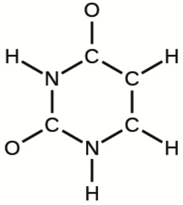
e) Carbonic acid:

7. How are single, double, and triple bonds similar? How do they differ?
★★ Questions
8. Correct the following statement: “The bonds in solid PbCl2 are ionic; the bond in a HCl molecule is covalent. Thus, all of the valence electrons in PbCl2 are located on the Cl– ions, and all of the valence electrons in a HCl molecule are shared between the H and Cl atoms.”
9. Methanol, H3COH, is used as the fuel in some race cars. Ethanol, C2H5OH, is used extensively as motor fuel in Brazil. Both methanol and ethanol produce CO2 and H2O when they burn. Write the chemical equations for these combustion reactions using Lewis structures instead of chemical formulas.
10. Carbon tetrachloride was formerly used in fire extinguishers for electrical fires. It is no longer used for this purpose because of the formation of the toxic gas phosgene, Cl2CO. Write the Lewis structures for carbon tetrachloride and phosgene.
11. A compound with a molar mass of about 42 g/mol contains 85.7% carbon and 14.3% hydrogen by mass. Write the Lewis structure for a molecule of the compound.
Answers
1.
a) Eight electrons
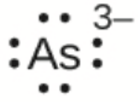
b) Eight electrons

c) No electrons, Be2+
d) Eight electrons

e) No electrons, Ga3+
f) No electrons, Li+
g) Eight electrons
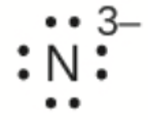
2.
a) 
b) 
c) 
d) 
e) 
f) 
3. In this case, the Lewis structure is inadequate to depict the fact that experimental studies have shown two unpaired electrons in each oxygen molecule.
a) 
b) 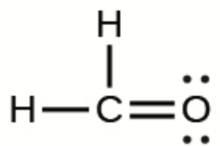
c) 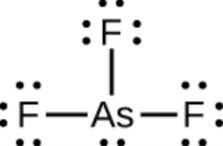
d) 
e) 
f) 
g) 
h) 
i) 
j) 
k) 
4.
a) 
b) 
c) 
d) 
5. 
6.
a) 
b) 
c) 
d) 
e) 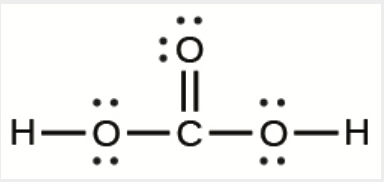
7. Each bond includes a sharing of electrons between atoms. Two electrons are shared in a single bond; four electrons are shared in a double bond; and six electrons are shared in a triple bond.
8. Two valence electrons per Pb atom are transferred to Cl atoms; the resulting Pb2+ ion has a 6s2 valence shell configuration. Two of the valence electrons in the HCl molecule are shared, and the other six are located on the Cl atom as lone pairs of electrons.
9.

10.

11.

Diagram showing lone pairs and bonding pairs of electrons in a molecule or an ion
Two (a pair of) valence electrons that are not used to form a covalent bond
Bond in which a single pair of electrons is shared between two atoms
Guideline which states that main group atoms will form structures in which eight valence electrons interact with each nucleus, counting bonding electrons as interacting with both atoms connected by the bond
Covalent bond in which two pairs of electrons are shared between two atoms
Bond in which three pairs of electrons are shared between two atoms
Number of pairs of electrons between two atoms; it can be found by the number of bonds in a Lewis structure or by the difference between the number of bonding and antibonding electrons divided by two
Molecule that contains an odd number of electrons
Describes a hypervalent molecule, which contains at least one main group element that has more than eight electrons in its valence shell
Describes a hypervalent molecule, which contains at least one main group element that has more than eight electrons in its valence shell
Charge that would result on an atom by taking the number of valence electrons on the neutral atom and subtracting the nonbonding electrons and the number of bonds (one-half of the bonding electrons)
Arrangement of atoms in a molecule or ion; in VSEPR theory, it refers to a structure that includes only the placement of the atoms in the molecule
Situation in which one Lewis structure is insufficient to describe the bonding in a molecule and the average of multiple structures is observed
Two or more Lewis structures that have the same arrangement of atoms but different arrangements of electrons
Average of the resonance forms shown by the individual Lewis structures


